The Volvo B10BLE (Bus chassis, 10-litre engine, Longitudinally-mounted, Low Entry) is a low-entry single-deck transit bus built by Volvo Buses, popular in Australia, Scandinavia and the United Kingdom. Commonly referred to as the “B10B”, it is the low-entry equivalent of the Volvo B10B city bus which has a stepped entrance. Like other Volvo buses, the chassis was manufactured in Sweeden.
Previously, Singapore’s major bus operator, SBS Transit, operated a sole diesel B10BLE demonstrator unit (SBS1688K) in its fleet, which has since been retired. SBS Transit also owns 12 Compressed natural gas (CNG)-powered variants, which continue to operate today. They are easily distinguished by their large roof pod, which houses CNG tanks.
All units were retired by July 2019. Two CNG units were preserved. SBS2988M is preserved at St. Andrew’s Autism Centre while SBS2989K is preserved at Tan Tock Seng Hospital.
Technical Data:
The original B10BLE was launched around 1992, available with a diesel engine. A later compressed natural gas (CNG) powered version was introduced, with the gas tanks mounted on the roof of the bus. The model was the direct successor to the popular B10M series.
The low-floor design was widely promoted by Volvo when it was first launched, on the basis of added convenience to the passengers, and the increase in transport efficiency due to the low-entry design, offering step-less access between the entry and exit doors. This bus was succeeded by the Volvo B7L, Volvo B7RLE, Volvo B12B and Volvo B12BLE.
The Volvo B10BLE features an inline four-stroke six-cylinder Volvo DH10A engine with a turbocharger and intercooler, delivering 245 horsepower. The engine is able to meet Euro II emissions standards. Optionally available is a Volvo GH10-series (GH10A, GH10B, GH10C) natural gas or biogas engine. All generations of this engine are in-line four-stroke six-cylinder spark-ignition engines with a turbocharger and intercooler, capable of meeting at least Euro III emission standards.
Demonstrator Unit (SBS1688K):
In 1997, Singapore Bus Service (SBS) introduced its very first low-entry bus, a diesel-powered Volvo B10BLE demonstrator unit from Volvo Buses. The model was the direct successor to the highly popular Volvo B10M series which SBS operated in large numbers at the time. On 12 January 1998, the bus was registered as SBS1688K.
Technical Specifications:
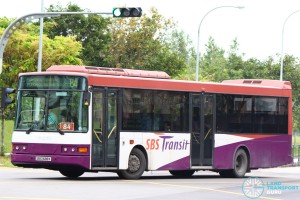
| SBS Transit Volvo B10BLE Diesel | |
| Engine | Volvo DH 10 A-245 |
| Transmission | ZF Ecomat 5HP 500 (5-speed automatic) |
| Bodywork | Volgren CR221L |
| EDS | Mobitec MobiDOT |
Additional Specifications:
SBS1688K was the first Euro-II compliant bus in Singapore, as well as being among the first few SBS buses that were introduced with an Electronic Display Signage (EDS).
On the inside, the bus featured a unique layout with just six seats in the front half of the bus. The design maximised standing space and incorporated two-branched stanchion poles in the centre for more standing space. Bucket seats by Saydair are used in place of older seat models. As no plans were made for ferrying passengers-in-wheelchairs, SBS1688K is not equipped with a wheelchair ramp, though a similarly designated wheelchair area is available on the bus, which is utilised as additional standing space.
The bus was originally deployed to Bedok North Depot in its early days, running on Service 16, and later 36 and 518. It was later redeployed to Hougang Depot until the end of its lifespan, serving on routes such as 80, 82, 84, 85 and 163. After being permanently deployed on Service 84 since 2014, the bus was laid-up on 11 January 2015 after 17 years on the roads, with no extension of lifespan.
SBS1688K had a licensed carrying capacity for 83 passengers, comprising 34 seating and 49 standing passengers.
CNG-Powered Variants (SBS2988M – SBS2999G):
In 2002, SBS Transit acquired two Compressed Natural Gas (CNG) powered Volvo B10BLE buses, as part of the CNG Pilot Project, a trial for the suitability of CNG buses (and taxis) for Singapore roads. The project, jointly undertaken by the Ministry of the Environment, SBS Transit and SembCorp Gas, was launched on 22 April 2002 along with the opening of the first CNG refilling station in Singapore, located on Jurong Island.
The first two units, SBS2988M and SBS2989K, were registered in April and July 2002 respectively. A further 10 units of the Volvo B10BLE (CNG variant) were registered in December 2005 and began revenue service the following year. By utilising cleaner CNG fuel, these buses met the Euro IV emission standards even before Euro III standards were adopted locally.
During the early years of introduction, these buses could only be refuelled on Jurong Island with CNG stations on the mainland not built until years later. They were originally deployed on Jurong Island services when launched (between Jurong East Interchange and Jurong Island). When private operators took over the services, they were redeployed on Boon Lay and Jurong East-region routes.
Technical Specifications:
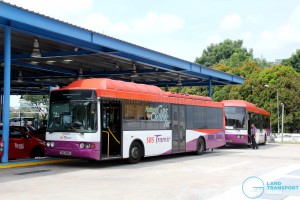
| SBS Transit Volvo B10BLE CNG | |
| Engine | Volvo GH 10 B-245 |
| Transmission | ZF Ecomat 4HP 500 (4-speed automatic) |
| Bodywork | Volgren CR222L |
Additional Specifications:
The CNG-powered buses are similar to the diesel-driven SBS1688K on the inside but bear distinct differences on the exterior. The larger front roof pod houses the CNG tanks, while the air-conditioning unit is the smaller unit located behind the CNG tanks. The additional weight of CNG storage components increased the vehicle unladen weight by over a tonne. These buses were also not equipped with Electronic Display Signs (EDS) (which were fitted to their predecessor SBS1688K), instead opting for plastic route destination plates. These buses were assembled by Soon Chow.
The first unit, SBS2988M, was registered on 19 Apr 2002 and commenced revenue service that same month. It was later followed up with SBS2989K, registered 18 July 2002. The two buses were deployed on Jurong Island Services 711, 712 and 713, and then transferred to Service 105 when SBS Transit decided not to continue operating these Jurong Island routes. During the initial years of operation, fuel consumption and feasibility studies were being performed on these buses.
The remaining ten buses (SBS2990E – SBS2999G) were acquired in 2003, but kept in storage at Soon Lee Depot until their registration on 29 Dec 2005, commencing revenue service on 1st Jan 2006. Apart from waiting on the trial results, SBS Transit was reportedly also hesitant to deploy CNG buses due to their high maintenance and operation costs. CNG fueling facilities in Singapore are limited, making themthese buses dependent on a small number of commercial fueling points outside of bus depots (which only have diesel filling facilities).
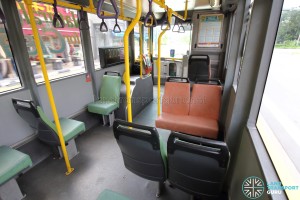
Despite being low-entry, these buses are not equipped with a wheelchair ramp, though a similarly designated wheelchair area is available on the bus, which is utilised as additional standing space.
CNG B10BLE buses have a licensed capacity for 84 passengers, with 35 seating and 49 standing passengers.
More interior pictures on Page 2 of this article.
Deployments
All Volvo B10BLE CNG buses were based out of Soon Lee Bus Depot for most of their lifespan, where they were commonly deployed on Service 66, 105, 143, 157, 183 & 243G/W. Buses were refuelled at either Jurong Island or Toh Tuck.
In late February 2017, all buses were transferred to Bukit Batok Bus Depot until their eventual retirement in 2019. They were regularly deployed to Bus Services 99, 156 & 175.
Early Retirement
4 of the Production Batch buses; SBS2990E, SBS2995S, SBS2998J & SBS2999G were retired in January 2019, about 4 years earlier than their statutory lifespan of 17 years.
The rest of the running production batch buses; SBS2991C – SBS2994U, SBS2996P & SBS2997L were retired in July 2019, about 3 years earlier than their statutory lifespan of 17 years. These buses were officially de-registered in September 2019.
With the gradual phasing-out of plastic route destination plates in favour of Electronic Display Signs (EDS), buses such as the Volvo Olympian (Batch 3), Volvo B10TL and Volvo B9TL (CDGE) were all retrofitted with EDS units. However, the CNG Volvo B10BLE buses were never retrofitted with EDS units, and were the last public buses in Singapore to feature plastic route destination plates when retired.
Preserved Buses
SBS2988M is preserved at St. Andrew’s Autism Centre located at Elliot Road in early 2020.
In December 2019, it was announced that Tan Tock Seng Hospital (TTSH) would soon be getting a decommissioned single-deck SBS Transit bus, slated to be part of a mobility circuit at the future Integrated Care Hub next to the hospital. SBS2989K was spotted at Tan Tock Seng Hospital in May 2021.
CNG Buses in Singapore
CNG buses have not caught on with both public and private operators alike, mainly due to their high cost of operation. Apart from being more expensive to purchase, CNG buses are limited to a very small number of refuelling points, which limits operational flexibility. Maintenance costs are also high for small fleet owners like SBS Transit, where they do not benefit from the economies of scale offered by operating large numbers of a single bus model.
Safety concerns with CNG buses were raised in August 2010 when a King Long coach operated by Sun Gee Travel exploded. The 56-year-old bus driver suffered nearly 40 per cent burns on his body, and died in hospital a few days later. The Land Transport Authority (LTA) impounded 22 coaches of the same model (all owned by Sun Gee), and an investigation later revealed that a missing ferrule (a type of fastener) could have allowed gas to seep into the bus. In addition, the investigation revealed several design flaws that were acknowledged by the manufacturer, Xiamen King Long. While SBS Transit’s Volvo B10BLEs were unaffected, Sun Gee converted all their CNG King Long buses to run on diesel.
In May 2017, following two cases of CNG Toyota Wish taxis erupting in flames within two months, the LTA demanded all CNG vehicles in Singapore be inspected for leaks. This included 13 buses — comprising 12 public buses (Volvo B10BLEs) and one private bus — and seven goods vehicles. SBS Transit’s CNG Volvo B10BLEs returned to service after the inspection.
Interior
The front portion of the bus seats three-abreast with a central aisle running the length of the bus. Grab poles and overhead hand grips are located on both sides of the aisle. All seats also have hand grips to provide commuters with additional support.
Bus stopping bell-pushes are located around the bus cabin, mounted to stanchion poles. Emergency hammers are mounted on pillars in-between windows.
At the front of the bus, located just behind the driver, is a granny seat for one. The ticket validator is retained as a ticket printer after magnetic farecards were phased out, and issues paper tickets as proof of cash payment.
The bus also features a small standing area opposite the exit door. Although the bus features a low-entry design, no wheelchair ramp was installed or retrofitted to this bus. In other regions, wheelchair ramps are installed and the standing area doubles as a wheelchair bay.
Towards the rear of the bus are more forward-facing seats. The last row of the bus has five forward-facing seats.
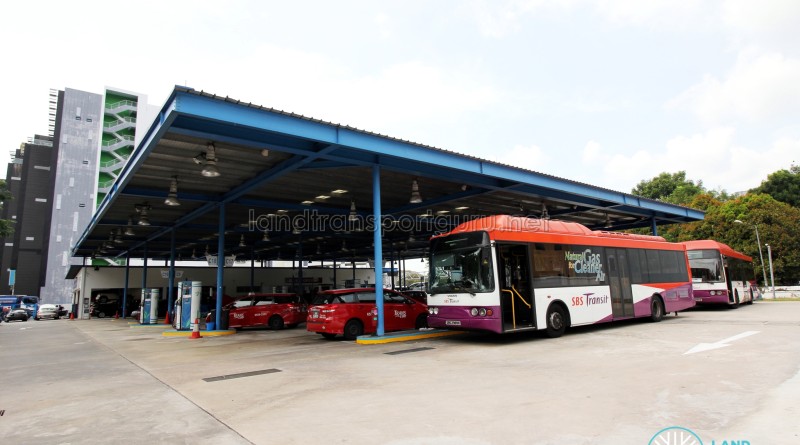
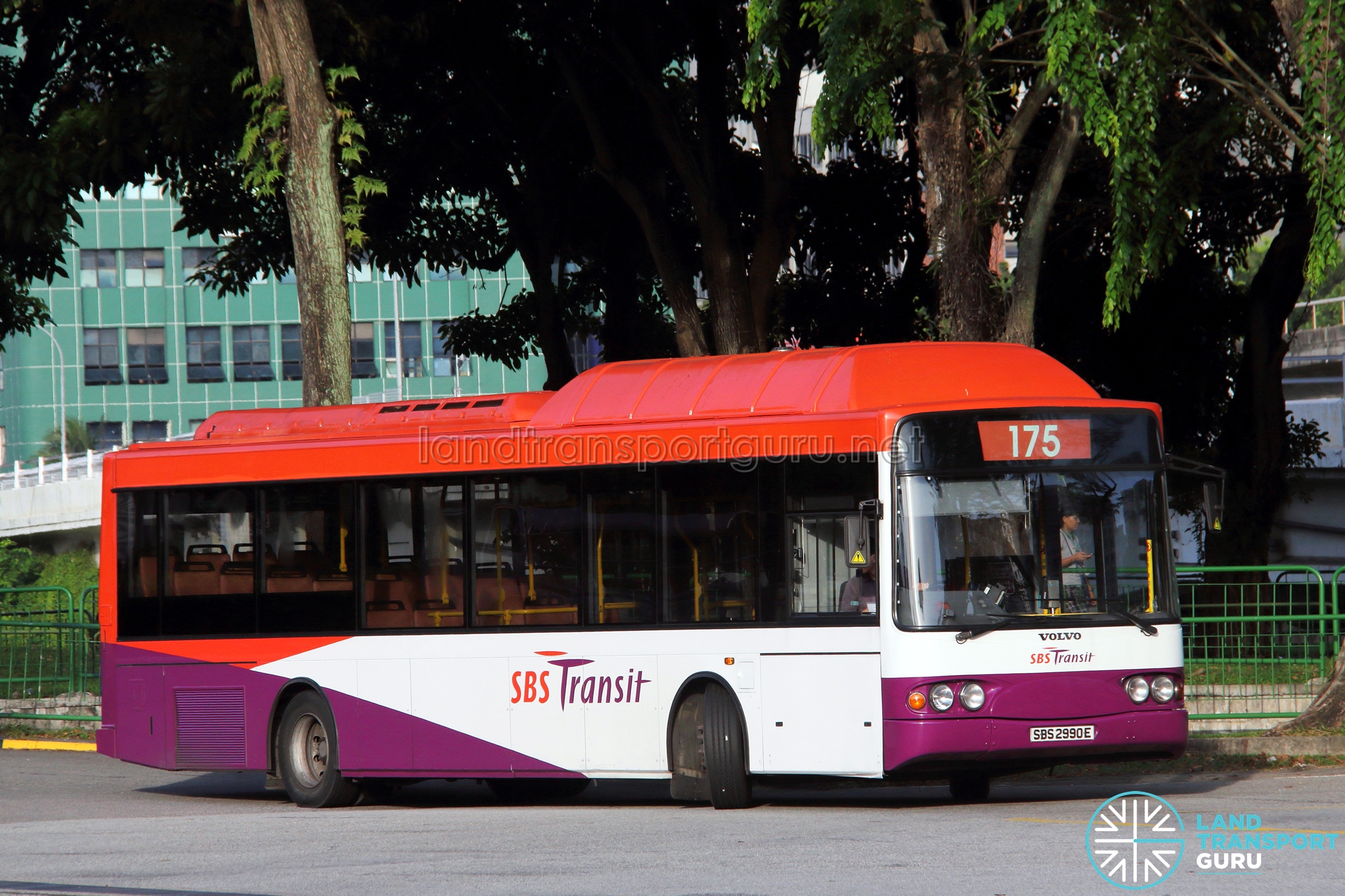
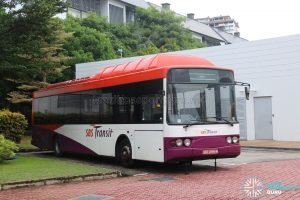
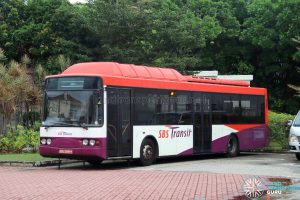
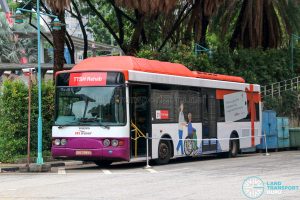
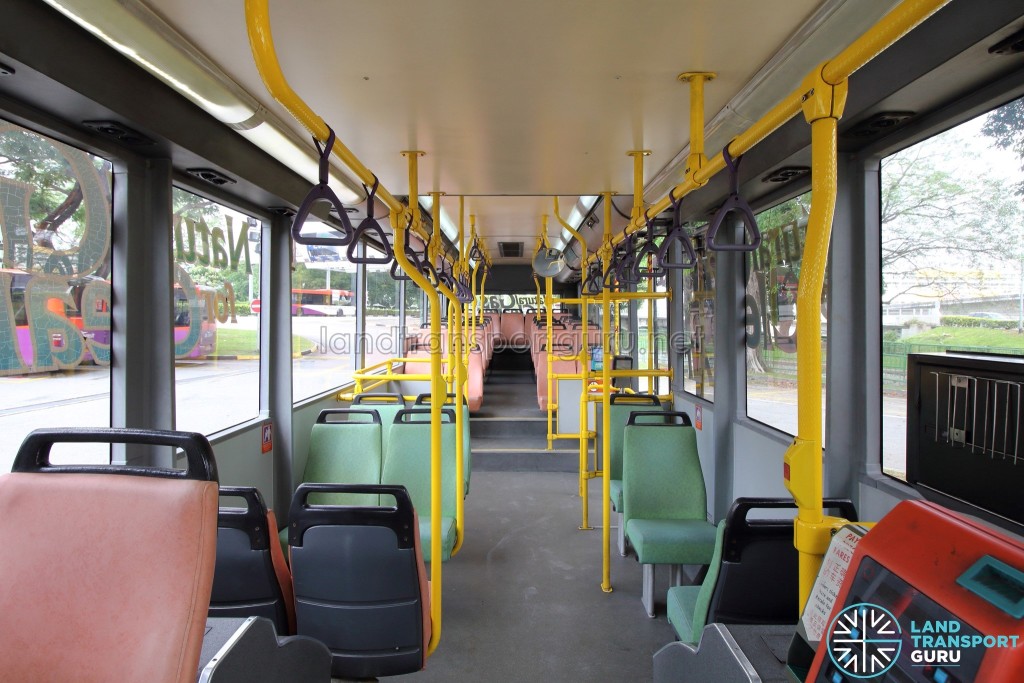
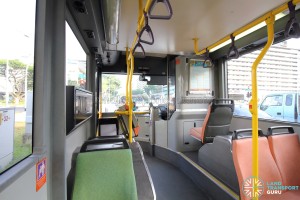
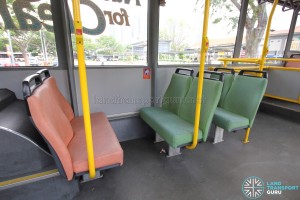
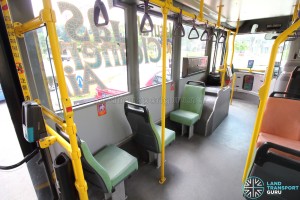
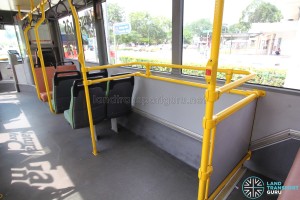
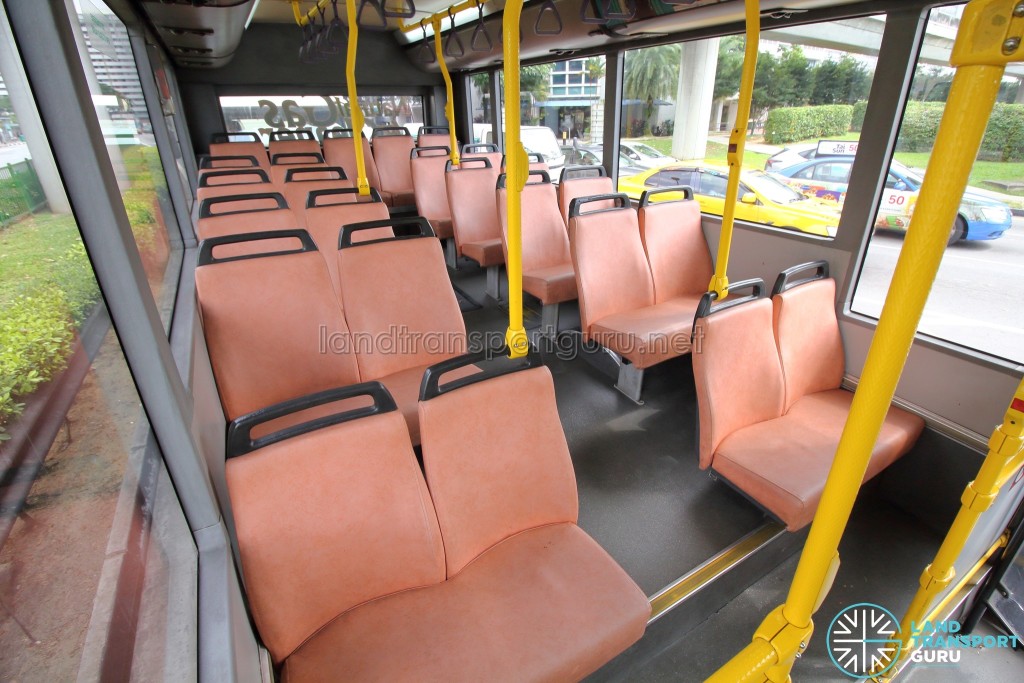
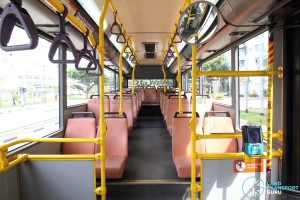
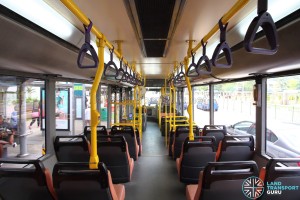
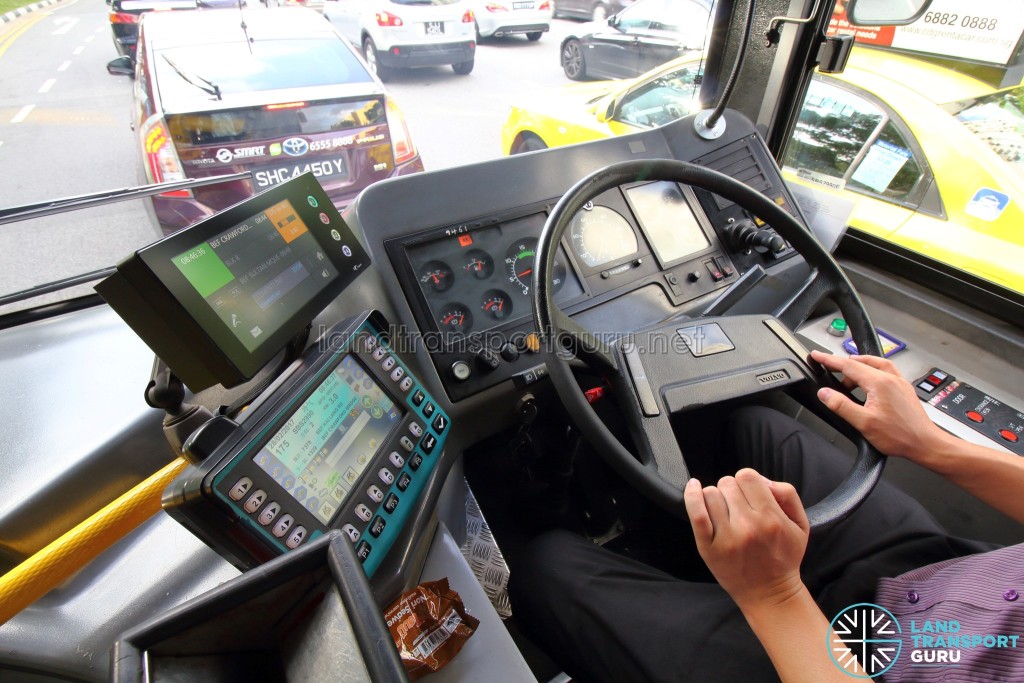
After modifying SBS2989K with wheelchair accessibility, they should have inserted a Hanover EDS and its lifespan extended by two years to 2024 and then it can continue serving as the sole CNG bus until its retirement with other Euro IV buses like the K230UB.
SBS2989K has somehow been preserved but its whereabouts is unknown.
SBS2989K is now at TTSH
All Volvo B10BLEs were de-registered on 2 Sep 2019.